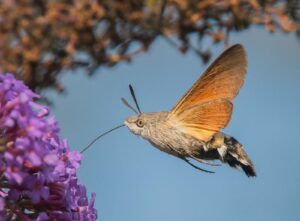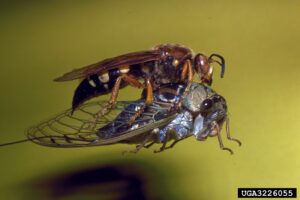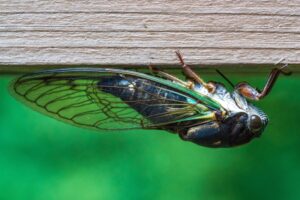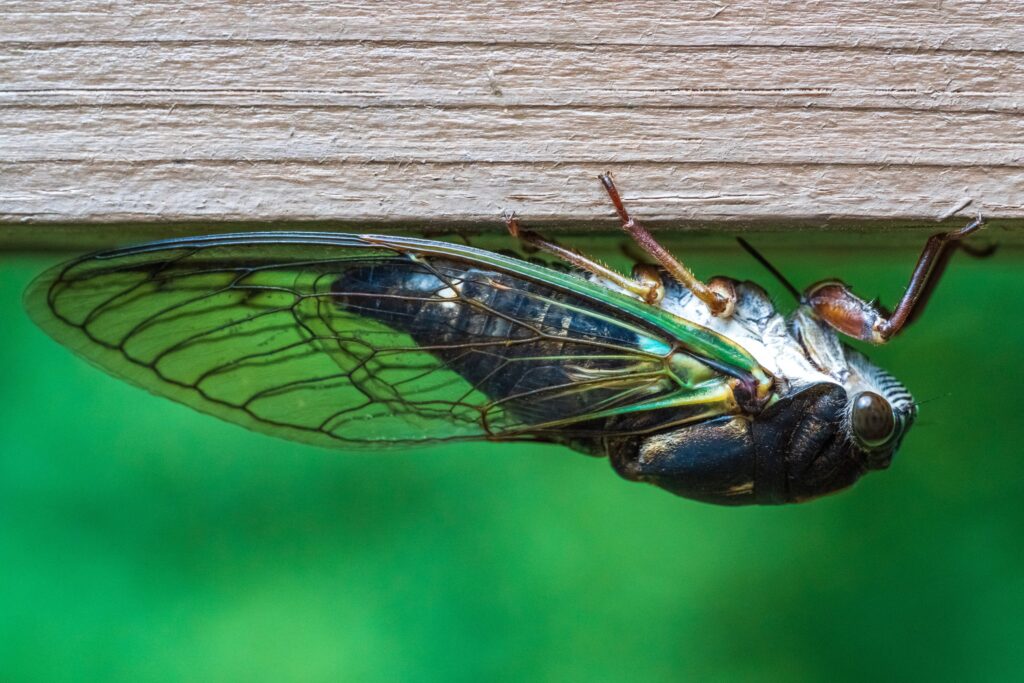The more I study nature, the more I stand amazed at the work of the creator. Louis Pasteur, French Chemist

It was just a quiet Saturday morning, the neighborhood lawn enthusiasts had not yet revved up their mower engines. The grass was sparkling with dew and I was watering my perennials. I’d bent down to pull a few weeds when something suddenly struck the middle of my back. I shook it off and began to search for the culprit. At first sight, I thought it was my friend, the Hummingbird Clearwing Moth. But a closer look revealed a very different insect. While the Hummingbird Moth has a furry-looking striped body with a rather flared tail, this one also had clear wings but its body was a very shiny black, tapered at the tail, with distinctive yellow markings. It definitely resembled the shape of a wasp but was somewhat larger. It also held tightly in its clutches another insect that appeared dead and the wasp-like creature appeared to be eating it. I later learned differently.
I ran inside to get my phone to document my find and snapped quite a few shots of it. I’d been hearing a lot about a killer wasp that had invaded the state of Washington. Not being familiar with the whole story, I wondered if perhaps one had found its way to our back yard and I almost convinced myself that it could be true. In my haste, I even made an attempt to step on it. That’s when it became agitated and began to chase me. I made my escape and went inside. A quick Google search showed me a photo that completely matched my own and it was identified as a Cicada Killer Wasp, not to be confused with the Asian Killer Hornet. I was quite relieved that I’d not killed my visitor.
 After studying a bit about the species I learned that the female has a stinger that can deliver a potent punch but that they typically aren’t aggressive toward humans. Not so with cicadas, however, which are often swept up mid-air and stung, as was happening at the onset of my encounter, causing the collision with my back. The venom paralyzes the cicada so that the killer wasp can carry it back to its underground home and stash it, along with others, in each of the nests she has created. She will then deposit eggs in each nest and when the larvae hatch, these still-living cicadas will nourish them until they are ready to emerge and complete their one-year life cycle.
After studying a bit about the species I learned that the female has a stinger that can deliver a potent punch but that they typically aren’t aggressive toward humans. Not so with cicadas, however, which are often swept up mid-air and stung, as was happening at the onset of my encounter, causing the collision with my back. The venom paralyzes the cicada so that the killer wasp can carry it back to its underground home and stash it, along with others, in each of the nests she has created. She will then deposit eggs in each nest and when the larvae hatch, these still-living cicadas will nourish them until they are ready to emerge and complete their one-year life cycle.
Now let’s take a moment to consider the cicada. You can’t live through a Missouri summer without hearing the song of this interesting insect. And what child has not delighted in the discovery of a crusty shell left behind by the emerging adult, typically in the perfect likeness of the living creature? There are more than three thousand species of cicadas throughout the world and many remain undescribed.
 The singing we hear is the males calling for a mate. Once mating occurs, the female lays her eggs in slits cut into tree bark. Newly hatched nymphs fall to the ground and burrow, some as deep as eight feet, where they will spend most of their lives. Their strong front legs enable them to excavate chambers in proximity to roots where they feed on sap. They may be nibbling on some of your plants tender roots right now and, as they do, their bodies and the excavated chambers become encrusted with cast-off fluids. When the time is ripe, they tunnel to the surface and shed their skins for the last time, leaving behind that exoskeleton that your child or grandchild found so exciting.
The singing we hear is the males calling for a mate. Once mating occurs, the female lays her eggs in slits cut into tree bark. Newly hatched nymphs fall to the ground and burrow, some as deep as eight feet, where they will spend most of their lives. Their strong front legs enable them to excavate chambers in proximity to roots where they feed on sap. They may be nibbling on some of your plants tender roots right now and, as they do, their bodies and the excavated chambers become encrusted with cast-off fluids. When the time is ripe, they tunnel to the surface and shed their skins for the last time, leaving behind that exoskeleton that your child or grandchild found so exciting.
Some are referred to as annual cicadas, but that doesn’t mean they complete their life cycle in one year. Most experience a two to five-year cycle allowing a rotation of sorts that produces a new crop every summer, some years greater in number than others. And then there are the species that experience a thirteen or seventeen-year cycle. Can you imagine digging and foraging roots for all those years only to surface, reproduce and die, most of them within a few weeks after their emergence? And let’s not forget their odds of becoming someone’s lunch.
God created a wonderful balance in nature, one in which each creature was blessed with a unique array of tools enabling it to survive instinctively. Some do survive and some become prey so that others may eat. They all serve to maintain a balance in the circle of life.
 The human creature was given an extra tool, the power to reason. Then we were given a choice. We can choose between life and death. We will all leave this earth in due time, but we have the gift of choosing whether or not we continue to live on into eternity.
The human creature was given an extra tool, the power to reason. Then we were given a choice. We can choose between life and death. We will all leave this earth in due time, but we have the gift of choosing whether or not we continue to live on into eternity.
….choose today whom you will serve….as for me and my family, we will serve the Lord. Joshua 24:15



I’ve got to be honest, Marcy. This one creeped me out a little!! I am not a fan of insects but I do love the message at the end! Thank you for your faithfulness to writing these articles!